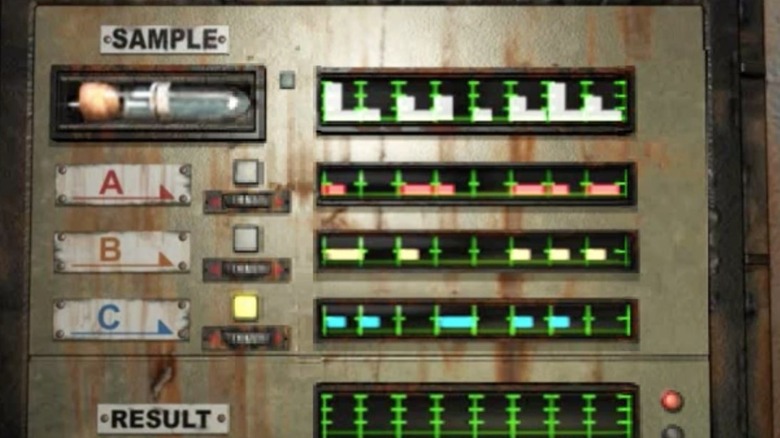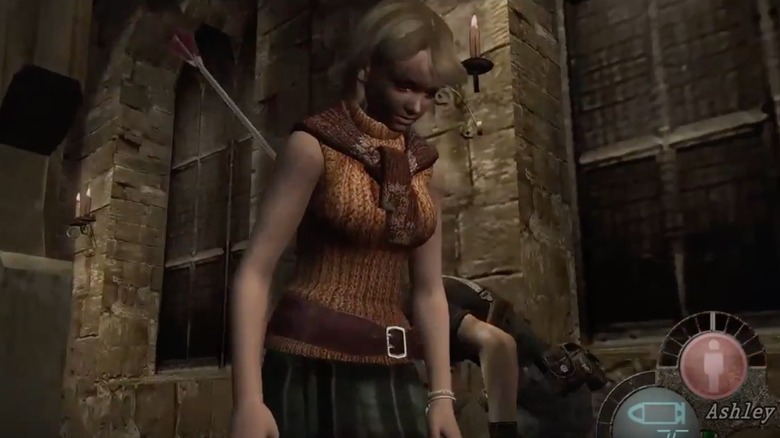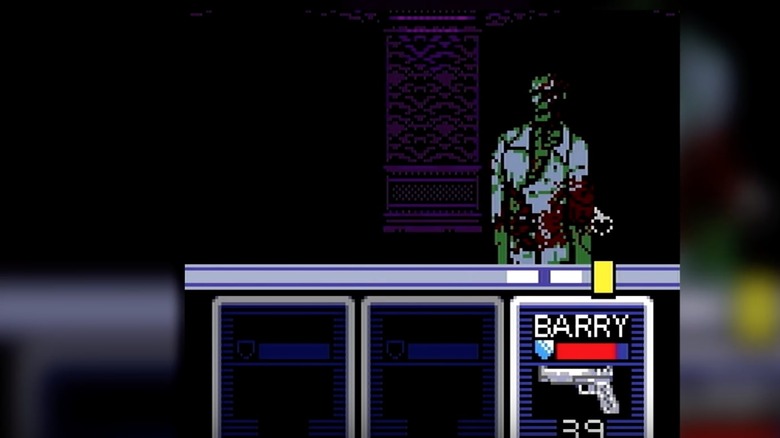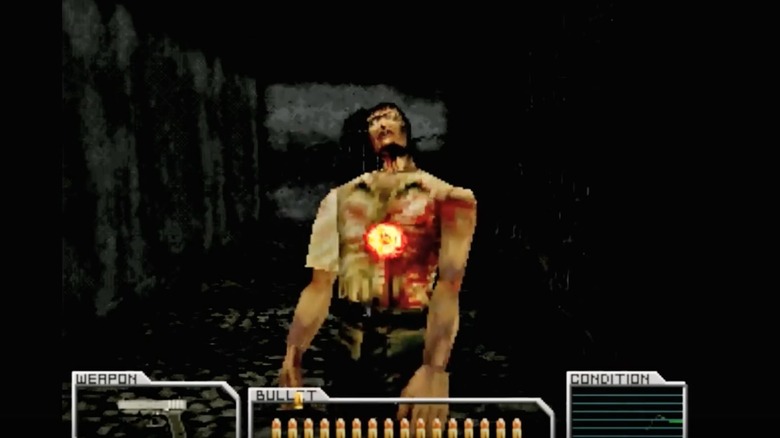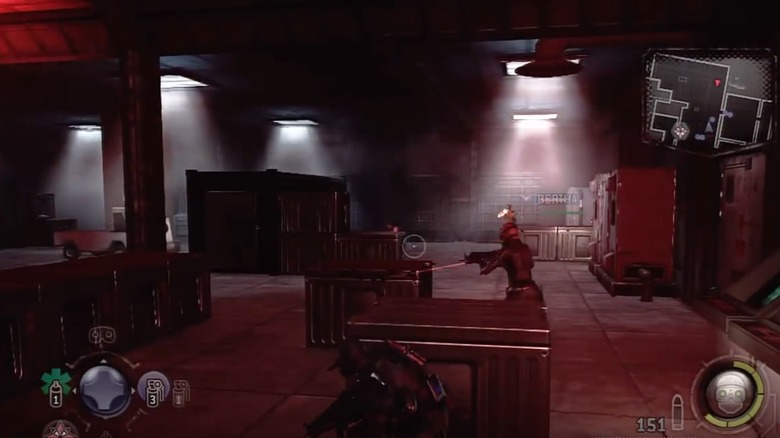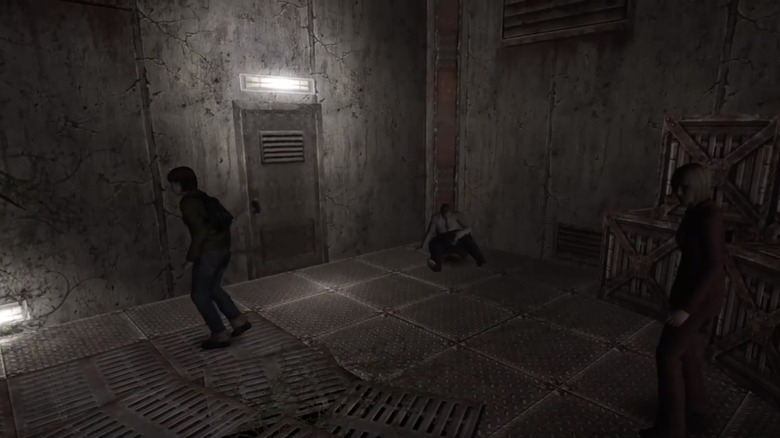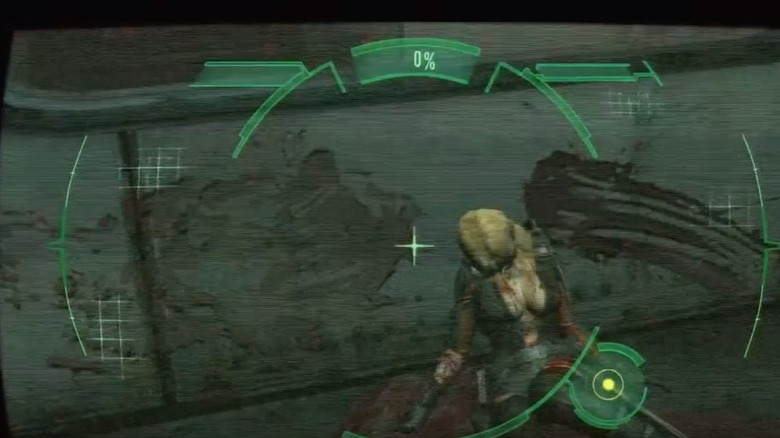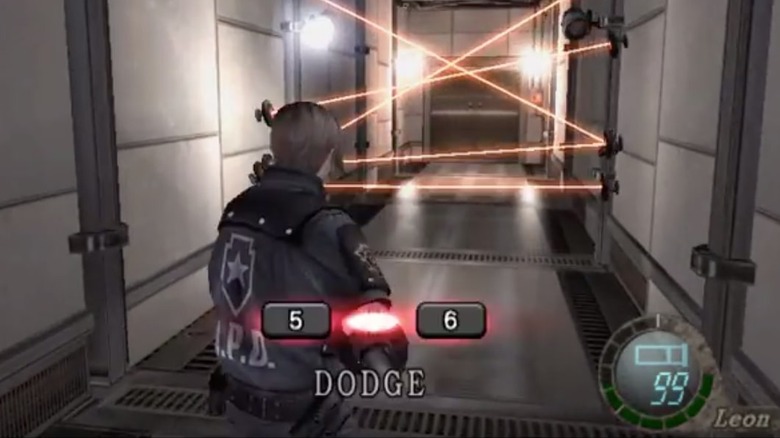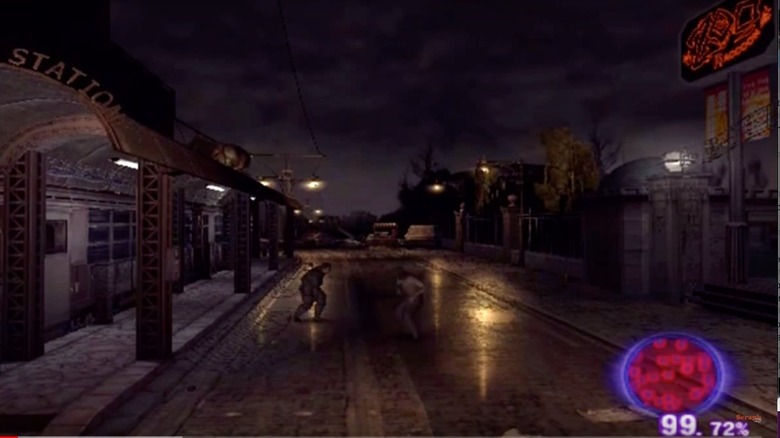Things In Resident Evil That Made Us Want To Rage Quit
For more than 20 years, the Resident Evil series has brought horror game fans a multitude of fantastic mainline titles, remakes that built upon their predecessors, and even a few handheld games. More than 25 games have been released to date across multiple console generations. Who knew back in 1996 when the first Resident Evil game released, that it would turn into one of the most recognized video game franchises ever?
The series became such a huge part of the gaming industry for many reasons, including some of its more frustrating qualities. Whether it's the inventory management system that required you to do basic geometry or the ammo scarcity at the most dire of times, you've likely found something memorable about the Resident Evil games that also annoys you. However, this isn't about those features that provided minor annoyance, but didn't stop you from loving the games. This is about those things that made you want to break controllers, game discs, and genuinely rage quit the series forever.
Partner AI (Resident Evil 5)
In 2009, Capcom released Resident Evil 5, the seventh mainline game in the series. The story had gamers taking control of BSAA agent Chris Redfield or his partner Sheva Alomar in an effort to stop a terrorism threat. Deviating from the mainline series formula, 5 was designed for two-player co-op. Two friends could team up and play through the entire story together, which resulted in a much more action-oriented experience, as opposed to the previous survival horror tone.
While the new direction was divisive among fans, pretty much everyone could agree on one thing: playing the game solo was often a nightmare because of the bad partner AI. The AI-controlled player was frustrating, as it had a tendency to waste ammo and health items, the two things you need the most of in this game. There were also sections where the two characters would separate, meaning you had to rely on an AI partner to navigate through enemies successfully to continue. This didn't work nearly as well as it should have, and it led to many a "Game Over" because the AI died.
Played as a co-op game, Resident Evil 5 was a fantastic experience, one that rewarded teamwork and communication. However, played alone, the poor AI made you want to eject your disc and throw it out of the nearest window.
The water sample puzzle (Resident Evil 3)
The Resident Evil series has often utilized puzzles in unique, interesting ways. Whether it's the chess plugs from RE2 or the Dog's Head door from RE7, Capcom has provided players with some fantastic brain-twisters throughout the years. However, for every great puzzle that people discuss with reverence, there's likely one that makes them want to snap the game disc in half. In Resident Evil 3: Nemesis, that one's known as the Water Sample Puzzle.
After reaching the monitor room in Nemesis, you had to embark on an extremely difficult puzzle involving a water sample you picked up in a previous room. After placing the sample into a machine, you were shown a panel displaying five screens, with the middle three screens showing red, yellow, and blue blocks, respectively. You had to shift these sets of blocks in order to recreate the combination shown on the very top screen. To do so, you had to turn the corresponding A, B, and C switches left or right to line up the blocks based on the illustrated pattern. Just seeing it for the first time hurt your brain, and solving it was an absolute nightmare, especially because there were four different solutions that were dependent on the game's difficulty levels.
Escorting Ashley (Resident Evil 4)
Seriously, does anyone actually enjoy escort missions? Babysitting AI-controlled characters while trying to solve puzzles or defeat enemies just seems annoying, and yet so many iconic game franchises have implemented them. Well, Resident Evil got in the escort mission mix with RE4, which put you in control of Leon Kennedy as he embarked on a quest to save the US president's daughter, Ashley Graham.
After finding Ashley, who was kidnapped by a creepy cult, sections of the game required you to escort her to escape from enemies or solve puzzles. The problem was — much like in its successor RE5 — that the character AI just wasn't very good. Ashley would sometimes wander throughout areas during gunfights, walking right into your line of sight. If you accidentally shot her instead of the enemy you were actually aiming for, she would die and you would get hit with a "Game Over."
Outside of the bad AI, every task became more of a chore when Ashley was involved. If you jumped down from a ledge, you'd have to turn around and catch her. Otherwise, she'd just stay wherever you left her. On top of that, you couldn't leave her alone for long either, as enemies will appear out of nowhere and take her away. While RE4 was a brilliant game for many reasons, escorting Ashley wasn't one of them.
First-person combat (Resident Evil Gaiden)
Some of you may not remember the Game Boy Color exclusive Resident Evil Gaiden. Why would you? The 2001 title wasn't well received. It was panned for its poorly designed save point system, visual style, and underwhelming puzzles. But its main point of frustration came from its combat system.
Gaiden featured a top-down view. However, when you encountered enemies, the perspective would switch to first-person. After the perspective change, you would then have to time your attacks using a scrolling reticle. You had to press the action button when the reticle was in range of an enemy, as illustrated by a white bar, not unlike something you'd find in Mario Golf. It was a far cry from the nerve-racking, intense Resident Evil combat gamers had come to know and love, and it was so rage-inducing because it sucked any and all fun out of killing zombies.
While having an entry in the series on a handheld should have been exciting, the lame combat ruined it. Luckily for RE fans, this combat system didn't stick.
No save point (Resident Evil: Survivor)
When the original Resident Evil released, it utilized a unique save system. Throughout the game, you would happen upon ink ribbons, which took up space in your inventory, but allowed you to save at any of the game's typewriters. This made saving somewhat strategic, as you'd have to plan out your save based on your number of ink ribbons, while also memorizing where the most convenient typewriter locations were on the map. While it's certainly not the ideal save system, it wasn't nearly as bad Resident Evil: Survivor's.
In Survivor, you simply couldn't save your game progress. Released for the PlayStation in 2000, the light-gun shooter wasn't well received for many reasons: poor visuals, slow pacing, and the fact that it was a gun game that didn't come with a gun for the American release. But one of the most baffling problems was its lack of any kind of save point. For whatever reason, Capcom designed this came so that you couldn't store any of your progress, meaning that you'd have to beat this four-hour game in one go. If you died, you had to start over. If you quit to simply enjoy the real world, you had to start over. In fact, the only way to ever save the game was if you died and decided not to continue. Your weapons, items, and ammo would carry over to your next playthrough, but you'd still start the game all over again.
Auto snap-to-cover (Operation Raccoon City)
Cover-based shooting has become a big part of video games. Ghost Recon: Advanced Warfighter featured it and Gears of War arguably perfected it, but many other games have tried their versions of it. In Resident Evil: Operation Raccoon City, Capcom decided to automate the mechanic, implementing a snap-to-cover system that ended up being an extremely annoying part of a critically-panned title.
Reviewers hated the game's design, shoddy AI (seeing a trend here?), and action-heavy style. However, it was the auto-cover system that turned out to be its most frustrating aspect. Any time your character went to pick up an item or some ammo, there was a chance that you'd end up jumping into cover automatically. The snap-to-cover system ensured that, if you were near any wall or barrier, you'd end up doing your best Marcus Fenix impersonation. Sure, it doesn't sound like a big deal. But imagine being forced into cover during a hectic fight when your only goal is to pick up a health spray. You'd bang your head against the wall. In cover.
No co-op communication (Resident Evil: Outbreak)
Back in 2002, Capcom released Resident Evil: Outbreak, a PlayStation 2 title with multiplayer support. Set in Raccoon City, Outbreak told its story through a series of episodic storylines centered around eight different "normal" characters, each taking place just days after the initial T-virus outbreak. Despite being rooted in the mainline RE lore, this game added in mechanics that the series had never seen before. The big addition was its cooperative gameplay.
An early PS2 title, Outbreak allowed players to tackle missions in up to four-player parties. However, the co-op never worked as well as it could have, because there was no voice communication. Players had to make do with a series of pre-set commands, which led to a lot of frustration. Accompanying that was the fact that other players could just go off on their own, exploring the world with no boundaries and no need to alert you. Outbreak's innovative design resulted in an interesting single-player game, but its multiplayer decisions led to a lot of headaches for those wanting some company during the journey.
Scanning everything (Resident Evil: Revelations)
Set between Resident Evil 4 and 5, 2012's Revelations followed Jill Valentine and Chris Redfield as they embarked on a quest to stop Earth's oceans from being infected by a virus. Originally released exclusively for the Nintendo 3DS, the survival horror game focused on stealth, evasion, and exploration. It also introduced a new mechanic: the Genesis scanner. The Genesis scanner allowed you to scan everything in sight. Whether you were looking into enemies or scanning rooms in order to find items, ammo, or health items, this scanner acted as a necessary crutch throughout the game.
On paper, the mechanic was beneficial, as it gave you a free herb every time the device hit 100 percent capacity. However, the device ended up being a nuisance, as Revelations wanted you to use the scanner all throughout the game. If you were an achievement hunter, you'd have to scan every enemy in the game multiple times, many while they were alive, in order to 100 percent the game. This wasn't easy to do without taking damage and could result in death if you weren't extremely careful. And, because you could only scan things when the Genesis wasn't at capacity, it forced you to discard or use herbs just so you could continue scanning enemies and progress forward.
Quick-time events (Resident Evil 4, 5)
Resident Evil 4 added quick time events to the survival horror series. These days, you've likely encountered QTEs in a number of video games. However, back in 2005, the gameplay mechanic wasn't nearly as common, and that led to some unexpected frustration when it popped up in RE4. QTEs were used extensively during the game's cutscenes, and required you to hit the correct button prompt with perfect timing; otherwise, you'd see that dreaded "You Are Dead" text. Now, this was a brand new mechanic that Resident Evil fans weren't used to, and could result in a lot of lost progress since the game had no autosave option. There was nothing worse than missing an unexpected QTE prompt and being forced to go all the way back to your last typewriter save.
Resident Evil 5 continued on with the quick-time event mechanic, including in one of the game's most controller-smashing sections. In the "Execution Grounds" chapter, you and your partner had to navigate through water via a raft. One player would slowly turn a crank to move the raft, while the other would ride the raft and use QTE button prompts to avoid a giant, attacking crocodile. The button prompts would change depending on the difficulty, and the entire section was slow, cheap, and extremely maddening.
Instant deaths (Resident Evil 6)
Resident Evil 6 was a commercial miss for Capcom, one that saw the series dive headfirst into the third-person shooter genre. It was no longer about survival, but rather shooting your way out of every zombie encounter. Multiple storylines, big set pieces, and good graphics didn't save a game that had deviated so far from what made Resident Evil so beloved.
It didn't help, then, that RE6 offered some of the cheapest deaths in the entire series. While RE4 and 5 both featured QTEs that, if not performed with speed and accuracy, could result in a game over, 6 added in areas where you could be insta-killed if you didn't memorize exactly where your character was supposed to be. In Leon Kennedy's campaign, you'd find yourself exiting a subway station. As you exited, a car would crash into you, instantly resulting in your death. The only way to avoid it was to be standing on the very left side of the exit, something you'd never know unless you'd already died from it.
Another instant-death scenario sees you running for your life, trying to escape an enemy known as the Ustanak whenever it shows up. Similar to the Nemesis from RE3, this giant enemy will one-hit kill you if you don't run and hide from it. However, thanks to bad camera angles and cheap QTEs, it's easy to get insta-killed by the Ustanak through no actual fault of your own.
Virus gauge (Resident Evil: Outbreak)
A lack of co-op communication options wasn't the only problem with Resident Evil: Outbreak. The game introduced a Virus Gauge system, which was a percentage meter that determined how long you could spend on a level before dying. In the bottom-right corner of your screen, you'd see the meter and its corresponding percentage number. It essentially made each level a race against the clock.
The meter would rise based on a number of factors, the first of which was based on your character choice. Each playable character had their own default rate of infection, which you could slow down by using health items. However, the gauge would speed up when attacked by zombies or suffering from environmental effects like toxic gas.
Introducing this mechanic in a cooperative experience would have been fine if there were better communication options, but the Virus Gauge was a nightmare when playing solo. Your player was only afforded four item slots, meaning you had to choose whether to keep extra health items or ammo. Yet, because of the meter, there was no right answer for what to keep. Without health items, your gauge would rise. Without ammo, zombies would easily attack you and the gauge would rise. Plus, the meter was always right there in front of your face, basically acting as a doomsday clock, creeping nonstop toward your death.



